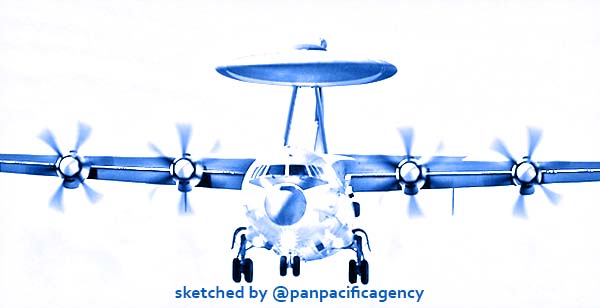[Analytics] Mission possible: China ramps up aircraft production

A slightly smaller version of an earlier four-turboprop plane, the KJ-500 is fixed with a phased-array radar developed by the Nanjing Research Institute of Electronic Technology. Credit: Air Team Images. Sketched by the Pan Pacific Agency.
China is mass-producing a genre of special mission warplanes that experts say will help create a full information system that allows the Chinese military to recognize every hostile movement and even sabotage enemy communications. Dave Makichuk specially for the Asia Times.
Shaanxi Aircraft Industry Corp. Ltd. (SAIC) under the state-owned Aviation Industry Corporation of China (AVIC) has been manufacturing special mission aircraft — including anti-submarine aircraft, early warning aircraft, surveillance aircraft and electronic warfare aircraft — with its pulse assembly line, China Central Television (CCTV) reported.
The advanced assembly line has the size of more than two soccer fields and fuses digital, information-oriented and intelligence concepts, CCTV said, noting that compared to the traditional assembly workshops at SAIC, the new pulse assembly line is 30% more efficient in manufacturing aircraft and requires less workers.
The pulse assembly line at SAIC has five stations, each is assigned with tasks of assembling certain components to its aircraft, said Peng Fei, chief engineer at SAIC.
Components will enter from station one, stopping at each station and leave station five as fully assembled aircraft ready for delivery, Peng said, noting that the next aircraft will enter the line as the previous one goes to the next station, enabling a very efficient manufacturing model.
The establishment of a pulse assembly line is an indication that China’s special mission aircraft have entered a mass-production phase, a military expert who asked not to be named told the Global Times.
“A pulse assembly line is only cost efficient when it produces a certain type of aircraft in large numbers, since the construction of such a line is expensive,” the expert said.
For instance, as many as 10 fully assembled special mission aircraft including Shaanxi KJ-500 early warning aircraft and other surveillance aircraft can be seen parked in an open area at SAIC in a single screenshot of the official CCTV report. They are scheduled to be delivered to the military following test flights.
The KJ500, the latest generation of AEW&C (Airborne Early Warning and Control) aircraft, “is earmarked to provide early radar warnings to combat troops to give them an edge in potential future battles,” War Is Boring, notes.
Capable of tracking nearly 100 vehicles at once, in early 2015 the Chinese military launched its new airborne early warning and control aircraft (AEW&C), taking to the skies with the People’s Liberation Army Air Force (PLAAF). It is similar to ZDK-03, sold to Pakistan by China, but with a new radar.
A slightly smaller version of an earlier four-turboprop plane, the KJ-500 is fixed with a phased-array radar developed by the Nanjing Research Institute of Electronic Technology.
The array consists of three parts, all housed within a saucer-shaped dome atop the aircraft. That dome also features a satellite communications antenna, as well as two passive electronic intelligence arrays.
Most of China’s special mission aircraft are designed based on the Y-8 transport plane because of its large payload capability and utility.
China for the first time displayed its special mission aircraft fleet at the National Day military parade on October 1. The fleet included Y-8 anti-submarine aircraft, KJ-500 early warning aircraft, Y-8 surveillance aircraft, Y-9 psychological warfare aircraft, Y-9 communications countermeasures aircraft, Y-8 electronic countermeasures aircraft, and Y-8 command and communications aircraft, according to Weapon magazine.
In the post-9/11 world, AEW&C platforms have routinely been deployed on more counter-terrorism operations, AeroSociety online reported.
For example, global events that are seen as potential targets by terrorist organizations, such as the Olympics, the G8 Summit, the World Economic Forum and the FIFA World Cup are likely to now be patrolled by an AEW&C aircraft, which will monitor the airspace around the event and detect any airborne threats before they have chance to cause damage and direct defensive forces onto the threat.
The added capabilities that the AEW&C aircraft brings to an air arm make them not just highly valued assets but also high-value targets for any opposing military force which are seeking to gain air dominance.
In a wartime situation, seeking and destroying the enemy’s AEW&C platform or at least disabling its systems (via electronic warfare and radar jamming), to prohibit that force from having the asset in the battlespace would be a high priority.
In the modern threat environment, the average AEW&C aircraft must be able to find and detect new, evolving threats including unmanned aerial vehicles (UAVs), stealth aircraft, cruise missiles (both supersonic and hypersonic) and electronic warfare systems.